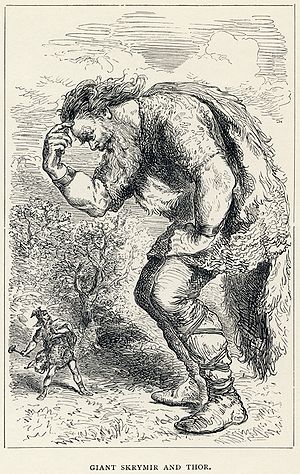Jötunheimr
This article may need to be rewritten to comply with Wikipedia's quality standards. (April 2018) |

The terms Jötunheimr (in
Etymology
Attestations
Poetic Edda
Jötunheimar are mentioned in three poems of the Poetic Edda. In the beginning of Völuspá, the coming of three women out of Jötunheimar marks the end of the Age of Gold for the gods.[5] Towards the end of the poem, in the section describing the onset of Ragnarök, they are mentioned as follows:
| Old Norse text[6] | Bellows translation[7] |
|---|---|
|
|
In the prose prologue
In
Gylfaginning

Jötunheimar are referenced throughout
Skáldskaparmál
Later in Skáldskaparmál,
Position in cosmology
Jötunheimar, along with other lands such as
Jötnar are typically found in the North and East, with explicit references to jötunheimar locating them in the North, however in Gylfaginning,
It has been proposed that rather than being conceived of as a physical land that can be located geographically relative to the regions of the world inhabited by humans, jötunheimar should be seen as connected to other realms by a number of passageways that cannot be traversed by ordinary means, and may seem contradictory from a naturalistic viewpoint in that a single location could be reached from a start point in a number of distinct directions. In this model, the jötunheimar would not be located in these opposing directions, only the passageways by which they are reached.[25] It has been further noted that in Eddic sources, it seems that jötnar are located to some extent in all directions and that they can be reached if one travels sufficiently far away from the area inhabited by people. From this, it has been suggested that it may be an intrinsic quality of jötnar as the "other" that they cannot be restricted to a single location, however, it is to be noted that not all these lands inhabited by jötnar are explicitly described as being jötunheimar.[26]
See also
Citations
- ^ Jǫtunheimr.
- ^ *etunaz.
- ^ *haimaz.
- ^ Jakobsson 2006, p. 106.
- ^ Bellows.
- ^ Völuspá (ON), Stanza 47 & 48.
- ^ Bellows 2004, Völuspá stanza 47 & 48.
- ^ Orchard 2011, pp. 59–67, För Skírns: Skírnir's journey.
- ^ Skírnismál (ON).
- ^ Heide 2014, pp. 107–108.
- ^ Orchard 2011, Þrymskviða: The lay of Thrym.
- ^ Þrymskviða (ON).
- ^ Heide 2014, p. 121.
- ^ Sturluson 2018, Gylfaginning, chapter 1. Of King Gylfi and Gefjonr, chapter 10. The arrival of Dagr and Nátt, chapter 14. About the residence of the gods and the origin of the dwarves, chapter 34. Of the children of Loki and the binding of the Fenris wolf.
- ^ Gylfaginning (ON), 1. Frá Gylfa konungi ok Gefjuni, 10. Tilkváma Dags ok Nætr, 14. Um bústaði goða ok upphaf dverga, 34. Frá börnum Loka ok bundinn Fenrisúlfr.
- ^ Sturluson 2018, Skáldskaparmál, chapter 2. The giant Þjazi carried off Iðunn, chapter 3. Loki secured Iðunn and the slaying of Þjazi.
- ^ Skáldskaparmál (ON), 2. Þjazi jötunn rænti Iðunni, 3. Loki náði Iðunni ok dráp Þjaza.
- ^ Sturluson 2018, Skáldskaparmál, chapter 24. About the giant Hrungnir, chapter 25. About the völva Gróa.
- ^ Skáldskaparmál (ON), 24. Frá Hrugni jötni, 25. Frá Gróu völu..
- ^ Nordvig 2013, p. 382.
- ^ Heide 2014, pp. 107–108, 131–134.
- ^ Jakobsson 2006, pp. 105–106.
- ^ Sturluson 2018, Gylfaginning, hapters 44-47.
- ^ Heide 2014, p. 118.
- ^ Heide 2014, pp. 107–108, 120–121, 131–134.
- ^ Jakobsson 2006, pp. 109–110.
Bibliography
Primary
- Bellows, Henry Adam (2004). The poetic Edda : the mythological poems. Mineola, NY: Dover Publications. ISBN 9780486437101.
- ISBN 9780141393728.
- Sturluson, Snorri (2018). The Prose Edda. Translated by Brodeur, Arthur Gilchrist. Franklin Classics Trade Press. ISBN 9780344335013.
- Bellows, Henry Adam. "The Poetic Edda: Voluspo". www.sacred-texts.com. Retrieved 3 July 2022.
- "Gylfaginning (ON)". heimskringla.no. Retrieved 7 November 2022.
- "Skáldskaparmál (ON)". heimskringla.com. Retrieved 5 November 2022.
- "Skírnismál (ON)". heimskringla.com. Retrieved 9 November 2022.
- "Þrymskviða (ON)". heimskringla.com. Retrieved 9 November 2022.
- "Völuspá (ON)". heimskringla.com. Retrieved 28 April 2023.
Secondary
- Heide, Eldar (2014). "Contradictory cosmology in Old Norse myth and religion – but still a system?". Maal og Minne (in Norwegian). 106 (1). ISSN 1890-5455. Retrieved 23 April 2022.
- Jakobsson, Ármann (2006). ""Where Do the Giants Live?"". Arkiv för nordisk filologi. 121: 101–112. Retrieved 6 May 2022.
- Nordvig, Mathias (2013). "A Method for Analyzing World-Models in Scandinavian Mythology". Aarhus University.
- ISBN 9780859915137.
- "Jǫtunheimr". Wiktionary. Retrieved 29 October 2022.
- "*etunaz". Wiktionary. Retrieved 20 November 2022.
- "*haimaz". Wiktionary. Retrieved 20 November 2022.

